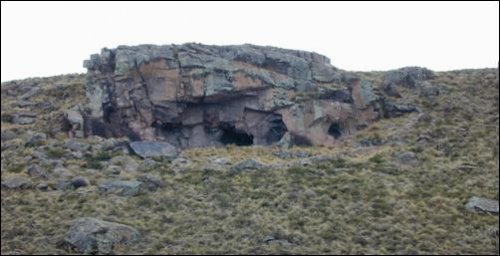A02-3 "Mollepunco"
The rock shelter of Mollepunco (aka Mollepunku, Cueva de Pirita) is one of the principal tourist destinations in the Upper Colca area (Cardona Rosas 2002: 143-147;Hostnig 2003: 52;Linares Málaga 1992: 287, 290, 291, 298) and it probably receives visitation by about ten groups of tourists per week during the high season. Formerly known as "Pirita" the shelter was renamed "Mollepunco" by Eloy Lináres Malaga in 1984 (1990;1992). This dry rock shelter at the base of a partly welded tuff outcrop consists of two principal cavities and with flat floors and sloping ceilings, and a dry outdoor activity area. The principal cavity is 7m deep, 4m wide, and 5m tall. The shelter is approximately 100 vertical meters above the Pulpera valley floor and it is adjacent to a small perennial stream. The shelter features pictographs and petroglyphs of camelid, bird, and humanoid figures that Augusto Cardona (2002: 143-147) argues are significant because they show the transition from pictographs to petroglyph techniques, and the art is believed to have been executed by herders and is therefore no older than 3000 BCE. The art has been interpreted as dating to relatively late periods because plump camelid figures are often shown in herds, and one solitary camelid has what appears to be a rope around its neck. The shelter was excavated by Linares (1992) and despite the gate blocking the entrance of one sector, it appears that the shelter was significantly looted. An open burial chamber probably dating to the LIP is evident high in the southern end of the rock shelter.
Figure6-33. Cueva de Mollepunco (A02-3).
Figure 6-34. Petroglyph of camelid on wall of Mollepunco.
Lithic debris is predominantly chert but a significant portion of the flaked material is obsidian. Bone and LIP ceramics are also evident at the site, perhaps resulting, in part, from the looted burial. Given the heavily visited and previously collected nature of this site surface the 2003 Upper Colca project field crew did not attempt a systematic recording of surface artifacts.

